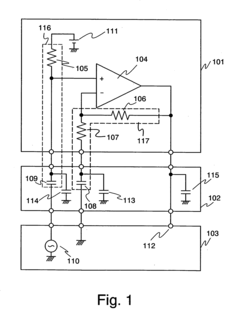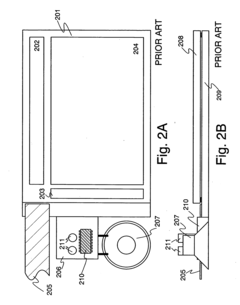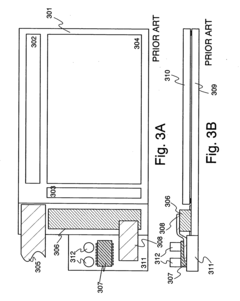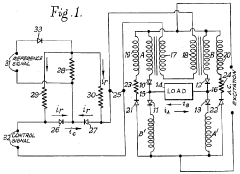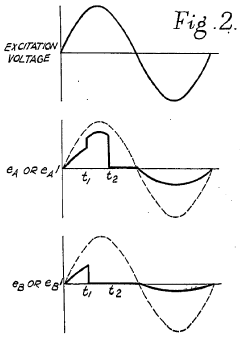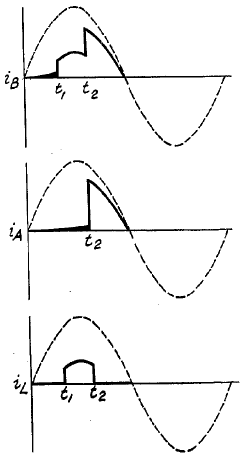How to Integrate Half Wave Rectifiers in Modern Infrastructure?
JUL 15, 202510 MIN READ
Generate Your Research Report Instantly with AI Agent
Patsnap Eureka helps you evaluate technical feasibility & market potential.
Half Wave Rectifiers: Background and Objectives
Half wave rectifiers have played a crucial role in the development of electrical and electronic systems since their inception in the early 20th century. These devices, which convert alternating current (AC) to pulsating direct current (DC), have undergone significant evolution to meet the changing demands of modern infrastructure. The primary objective of integrating half wave rectifiers into contemporary systems is to enhance energy efficiency, reduce power losses, and improve overall system performance.
The technological journey of half wave rectifiers began with simple diode-based designs, progressing through various semiconductor materials and circuit configurations. As power electronics advanced, the focus shifted towards minimizing harmonics, improving power factor, and increasing the rectification efficiency. This evolution has been driven by the growing need for more compact, efficient, and reliable power conversion solutions in various applications, from consumer electronics to industrial power systems.
In recent years, the integration of half wave rectifiers in modern infrastructure has gained renewed importance due to the rapid growth of renewable energy sources and the increasing electrification of transportation and industrial processes. These applications require sophisticated power conversion and management systems, where half wave rectifiers serve as fundamental building blocks. The challenge lies in adapting this technology to meet the demands of smart grids, electric vehicles, and high-power industrial equipment while maintaining high efficiency and reliability.
The current technological landscape presents several key objectives for the integration of half wave rectifiers. First, there is a pressing need to improve the power density of rectification systems, allowing for more compact and lightweight designs suitable for space-constrained applications. Second, enhancing the efficiency of half wave rectifiers across a wide range of operating conditions is crucial for reducing energy losses and improving overall system performance. Third, developing robust control strategies to manage the rectification process in dynamic and unpredictable environments is essential for ensuring stable operation in modern, complex power systems.
Another significant objective is the seamless integration of half wave rectifiers with advanced power electronic devices and control systems. This integration aims to create more intelligent and adaptive power conversion solutions capable of responding to varying load conditions and power quality requirements. Additionally, there is a growing emphasis on developing environmentally friendly rectification technologies that minimize electromagnetic interference and reduce the use of hazardous materials in their construction.
As we look towards the future, the integration of half wave rectifiers in modern infrastructure will likely focus on leveraging emerging materials and technologies. This includes exploring the potential of wide-bandgap semiconductors, such as silicon carbide and gallium nitride, to push the boundaries of rectifier performance. Furthermore, the incorporation of artificial intelligence and machine learning algorithms into rectifier control systems holds promise for optimizing performance and predicting maintenance needs in real-time.
The technological journey of half wave rectifiers began with simple diode-based designs, progressing through various semiconductor materials and circuit configurations. As power electronics advanced, the focus shifted towards minimizing harmonics, improving power factor, and increasing the rectification efficiency. This evolution has been driven by the growing need for more compact, efficient, and reliable power conversion solutions in various applications, from consumer electronics to industrial power systems.
In recent years, the integration of half wave rectifiers in modern infrastructure has gained renewed importance due to the rapid growth of renewable energy sources and the increasing electrification of transportation and industrial processes. These applications require sophisticated power conversion and management systems, where half wave rectifiers serve as fundamental building blocks. The challenge lies in adapting this technology to meet the demands of smart grids, electric vehicles, and high-power industrial equipment while maintaining high efficiency and reliability.
The current technological landscape presents several key objectives for the integration of half wave rectifiers. First, there is a pressing need to improve the power density of rectification systems, allowing for more compact and lightweight designs suitable for space-constrained applications. Second, enhancing the efficiency of half wave rectifiers across a wide range of operating conditions is crucial for reducing energy losses and improving overall system performance. Third, developing robust control strategies to manage the rectification process in dynamic and unpredictable environments is essential for ensuring stable operation in modern, complex power systems.
Another significant objective is the seamless integration of half wave rectifiers with advanced power electronic devices and control systems. This integration aims to create more intelligent and adaptive power conversion solutions capable of responding to varying load conditions and power quality requirements. Additionally, there is a growing emphasis on developing environmentally friendly rectification technologies that minimize electromagnetic interference and reduce the use of hazardous materials in their construction.
As we look towards the future, the integration of half wave rectifiers in modern infrastructure will likely focus on leveraging emerging materials and technologies. This includes exploring the potential of wide-bandgap semiconductors, such as silicon carbide and gallium nitride, to push the boundaries of rectifier performance. Furthermore, the incorporation of artificial intelligence and machine learning algorithms into rectifier control systems holds promise for optimizing performance and predicting maintenance needs in real-time.
Market Demand Analysis for Rectification Solutions
The market demand for rectification solutions, particularly half-wave rectifiers, has been steadily growing in recent years due to the increasing complexity and power requirements of modern infrastructure. This demand is driven by several key factors, including the rapid expansion of renewable energy systems, the evolution of smart grid technologies, and the proliferation of electric vehicles and their charging infrastructure.
In the renewable energy sector, half-wave rectifiers play a crucial role in converting the alternating current (AC) generated by solar panels and wind turbines into direct current (DC) for storage in batteries or integration into the power grid. As countries worldwide push for greater adoption of renewable energy sources to meet climate goals, the demand for efficient rectification solutions has surged. The global solar PV market, for instance, is projected to grow at a compound annual growth rate (CAGR) of over 20% in the coming years, directly impacting the demand for rectification technologies.
The development of smart grid systems has also contributed significantly to the market demand for rectification solutions. Smart grids require advanced power electronics for efficient energy distribution, voltage regulation, and power quality improvement. Half-wave rectifiers, when integrated into these systems, help manage the flow of electricity more effectively, reducing losses and improving overall grid stability. The smart grid market is expected to expand rapidly, with some estimates suggesting a market size of over $100 billion by 2025.
Electric vehicle (EV) charging infrastructure represents another major driver for rectification solutions. As the adoption of EVs accelerates globally, the need for efficient and reliable charging stations has become paramount. Half-wave rectifiers are essential components in EV chargers, converting AC power from the grid into DC power for vehicle batteries. With the EV market projected to grow exponentially in the coming decades, the demand for rectification solutions in this sector is expected to see substantial growth.
In the industrial sector, the integration of half-wave rectifiers in modern infrastructure is driven by the need for more efficient power conversion in various applications, including motor drives, uninterruptible power supplies (UPS), and industrial automation systems. The industrial automation market, in particular, is forecasted to grow at a CAGR of around 9% through 2026, further fueling the demand for advanced rectification technologies.
The telecommunications industry also contributes significantly to the market demand for rectification solutions. As 5G networks continue to expand globally, the need for reliable power conversion in base stations and data centers has increased. Half-wave rectifiers play a crucial role in ensuring stable power supply for these critical infrastructure components.
Overall, the market demand for rectification solutions, including half-wave rectifiers, is robust and diverse across multiple sectors. The integration of these technologies in modern infrastructure is essential for addressing the evolving power needs of a rapidly digitalizing and electrifying world. As industries continue to prioritize energy efficiency, power quality, and reliability, the demand for advanced rectification solutions is expected to maintain its upward trajectory in the foreseeable future.
In the renewable energy sector, half-wave rectifiers play a crucial role in converting the alternating current (AC) generated by solar panels and wind turbines into direct current (DC) for storage in batteries or integration into the power grid. As countries worldwide push for greater adoption of renewable energy sources to meet climate goals, the demand for efficient rectification solutions has surged. The global solar PV market, for instance, is projected to grow at a compound annual growth rate (CAGR) of over 20% in the coming years, directly impacting the demand for rectification technologies.
The development of smart grid systems has also contributed significantly to the market demand for rectification solutions. Smart grids require advanced power electronics for efficient energy distribution, voltage regulation, and power quality improvement. Half-wave rectifiers, when integrated into these systems, help manage the flow of electricity more effectively, reducing losses and improving overall grid stability. The smart grid market is expected to expand rapidly, with some estimates suggesting a market size of over $100 billion by 2025.
Electric vehicle (EV) charging infrastructure represents another major driver for rectification solutions. As the adoption of EVs accelerates globally, the need for efficient and reliable charging stations has become paramount. Half-wave rectifiers are essential components in EV chargers, converting AC power from the grid into DC power for vehicle batteries. With the EV market projected to grow exponentially in the coming decades, the demand for rectification solutions in this sector is expected to see substantial growth.
In the industrial sector, the integration of half-wave rectifiers in modern infrastructure is driven by the need for more efficient power conversion in various applications, including motor drives, uninterruptible power supplies (UPS), and industrial automation systems. The industrial automation market, in particular, is forecasted to grow at a CAGR of around 9% through 2026, further fueling the demand for advanced rectification technologies.
The telecommunications industry also contributes significantly to the market demand for rectification solutions. As 5G networks continue to expand globally, the need for reliable power conversion in base stations and data centers has increased. Half-wave rectifiers play a crucial role in ensuring stable power supply for these critical infrastructure components.
Overall, the market demand for rectification solutions, including half-wave rectifiers, is robust and diverse across multiple sectors. The integration of these technologies in modern infrastructure is essential for addressing the evolving power needs of a rapidly digitalizing and electrifying world. As industries continue to prioritize energy efficiency, power quality, and reliability, the demand for advanced rectification solutions is expected to maintain its upward trajectory in the foreseeable future.
Current Challenges in Half Wave Rectifier Integration
The integration of half wave rectifiers into modern infrastructure presents several significant challenges that need to be addressed. One of the primary issues is the inherent inefficiency of half wave rectifiers compared to full wave rectifiers. Half wave rectifiers only utilize one half of the AC cycle, resulting in lower power output and increased ripple in the DC output. This inefficiency can lead to increased power consumption and heat generation, which are critical concerns in modern infrastructure where energy efficiency is paramount.
Another challenge lies in the harmonics generated by half wave rectifiers. These harmonics can cause electromagnetic interference (EMI) and power quality issues in the electrical grid. As modern infrastructure becomes increasingly reliant on sensitive electronic equipment, the presence of harmonics can lead to malfunctions, reduced equipment lifespan, and potential safety hazards. Mitigating these harmonics often requires additional filtering components, which can increase system complexity and cost.
The size and weight of half wave rectifier systems also pose integration challenges in space-constrained modern infrastructure. While half wave rectifiers are generally simpler in design compared to full wave rectifiers, the need for larger smoothing capacitors to reduce ripple can offset this advantage. In applications where miniaturization is crucial, such as in compact power supplies or embedded systems, the space requirements of half wave rectifiers can be a limiting factor.
Thermal management is another significant challenge in integrating half wave rectifiers. The inefficiency of these devices results in higher heat generation, which can be problematic in densely packed modern infrastructure. Adequate cooling solutions must be implemented to prevent overheating and ensure reliable operation, potentially adding to the overall system complexity and cost.
The pulsating nature of the output from half wave rectifiers can also create challenges in voltage regulation. Modern infrastructure often requires stable and precise DC voltages for various applications. The inherent voltage fluctuations in half wave rectifier outputs necessitate more sophisticated voltage regulation circuits, which can increase system complexity and potentially reduce overall reliability.
Furthermore, the integration of half wave rectifiers must address the issue of power factor correction. Half wave rectifiers typically have a poor power factor, which can lead to increased losses in power distribution systems and potential non-compliance with power quality standards. Implementing power factor correction techniques adds another layer of complexity to the integration process.
Lastly, the reliability and longevity of half wave rectifiers in modern infrastructure applications are concerns that need to be addressed. The stress on components due to the pulsating current and voltage can lead to premature failure if not properly managed. Ensuring long-term reliability while maintaining cost-effectiveness is a delicate balance that engineers must strike when integrating these devices into critical infrastructure systems.
Another challenge lies in the harmonics generated by half wave rectifiers. These harmonics can cause electromagnetic interference (EMI) and power quality issues in the electrical grid. As modern infrastructure becomes increasingly reliant on sensitive electronic equipment, the presence of harmonics can lead to malfunctions, reduced equipment lifespan, and potential safety hazards. Mitigating these harmonics often requires additional filtering components, which can increase system complexity and cost.
The size and weight of half wave rectifier systems also pose integration challenges in space-constrained modern infrastructure. While half wave rectifiers are generally simpler in design compared to full wave rectifiers, the need for larger smoothing capacitors to reduce ripple can offset this advantage. In applications where miniaturization is crucial, such as in compact power supplies or embedded systems, the space requirements of half wave rectifiers can be a limiting factor.
Thermal management is another significant challenge in integrating half wave rectifiers. The inefficiency of these devices results in higher heat generation, which can be problematic in densely packed modern infrastructure. Adequate cooling solutions must be implemented to prevent overheating and ensure reliable operation, potentially adding to the overall system complexity and cost.
The pulsating nature of the output from half wave rectifiers can also create challenges in voltage regulation. Modern infrastructure often requires stable and precise DC voltages for various applications. The inherent voltage fluctuations in half wave rectifier outputs necessitate more sophisticated voltage regulation circuits, which can increase system complexity and potentially reduce overall reliability.
Furthermore, the integration of half wave rectifiers must address the issue of power factor correction. Half wave rectifiers typically have a poor power factor, which can lead to increased losses in power distribution systems and potential non-compliance with power quality standards. Implementing power factor correction techniques adds another layer of complexity to the integration process.
Lastly, the reliability and longevity of half wave rectifiers in modern infrastructure applications are concerns that need to be addressed. The stress on components due to the pulsating current and voltage can lead to premature failure if not properly managed. Ensuring long-term reliability while maintaining cost-effectiveness is a delicate balance that engineers must strike when integrating these devices into critical infrastructure systems.
Existing Half Wave Rectifier Integration Methods
01 Circuit design for half-wave rectifiers
Half-wave rectifiers are designed to convert alternating current (AC) to pulsating direct current (DC) by allowing current flow in only one direction. The circuit typically consists of a diode and a load resistor. During the positive half-cycle of the AC input, the diode conducts, allowing current to flow through the load. During the negative half-cycle, the diode blocks current flow, resulting in a pulsating DC output.- Circuit design for half-wave rectifiers: Half-wave rectifiers are designed to convert alternating current (AC) to pulsating direct current (DC) by allowing current flow in only one direction. The circuit typically consists of a diode and a load resistor. During the positive half-cycle of the AC input, the diode conducts, allowing current to flow through the load. During the negative half-cycle, the diode blocks current flow, resulting in a pulsating DC output.
- Efficiency improvements in half-wave rectifiers: Various techniques are employed to improve the efficiency of half-wave rectifiers. These may include the use of high-speed switching diodes, optimized circuit layouts to reduce parasitic capacitance, and the implementation of snubber circuits to suppress voltage spikes. Some designs incorporate synchronous rectification, where MOSFETs replace diodes to reduce forward voltage drop and improve overall efficiency.
- Applications of half-wave rectifiers in power supplies: Half-wave rectifiers find applications in various power supply designs, particularly in low-power or cost-sensitive applications. They are used in simple AC adapters, battery chargers, and some electronic devices where full-wave rectification is not necessary. In some cases, they are combined with voltage regulators or filtering circuits to produce smoother DC output for sensitive electronic components.
- Integration of half-wave rectifiers in IC designs: Half-wave rectifiers are increasingly integrated into integrated circuit (IC) designs for various applications. These integrated rectifiers often include additional features such as voltage regulation, overcurrent protection, and thermal shutdown. The integration allows for more compact and efficient designs in applications such as power management ICs, RF energy harvesting circuits, and sensor interfaces.
- Half-wave rectifiers in specialized applications: Half-wave rectifiers are utilized in specialized applications beyond traditional power supplies. These include signal demodulation in radio receivers, peak detectors in measurement equipment, and clamping circuits in analog signal processing. In some cases, they are used in voltage multiplier circuits to generate high voltages from lower AC inputs, finding applications in scientific instruments and high-voltage power supplies.
02 Efficiency improvements in half-wave rectifiers
Various techniques are employed to improve the efficiency of half-wave rectifiers. These may include the use of high-speed switching diodes, optimized circuit layouts to reduce parasitic capacitance, and the implementation of snubber circuits to suppress voltage spikes. Advanced control strategies and feedback mechanisms can also be incorporated to enhance overall performance and reduce power losses.Expand Specific Solutions03 Applications of half-wave rectifiers in power supplies
Half-wave rectifiers find applications in various power supply designs, particularly in low-power or cost-sensitive applications. They are used in simple AC adapters, battery chargers, and some electronic devices where full-wave rectification is not necessary. In some cases, they are combined with voltage regulators or filtering circuits to produce smoother DC output for sensitive electronic components.Expand Specific Solutions04 Integration of half-wave rectifiers in specialized circuits
Half-wave rectifiers are integrated into specialized circuits for specific applications. These may include peak detectors, signal demodulators, and voltage clamping circuits. In some designs, they are combined with other components to create more complex rectification schemes or to achieve particular voltage or current characteristics required for specialized electronic equipment.Expand Specific Solutions05 Miniaturization and packaging of half-wave rectifier circuits
Efforts are made to miniaturize half-wave rectifier circuits for integration into compact electronic devices. This involves the use of surface-mount components, integrated circuit designs that incorporate rectifier elements, and innovative packaging techniques. Some designs focus on thermal management and electromagnetic compatibility to ensure reliable operation in confined spaces or challenging environments.Expand Specific Solutions
Key Players in Power Electronics Industry
The integration of half wave rectifiers in modern infrastructure is currently in a transitional phase, with the market showing steady growth as industries seek more efficient power conversion solutions. The global market size for rectifiers is expanding, driven by increasing demand in sectors like telecommunications, renewable energy, and industrial automation. Technologically, half wave rectifiers are evolving towards higher efficiency and miniaturization. Companies like Infineon Technologies AG and ABB Group are at the forefront, developing advanced semiconductor solutions for improved rectification. Other key players such as Siemens Corp. and Mitsubishi Electric Corp. are also contributing to the technological advancements in this field, focusing on integrating smart features and enhancing overall system performance.
Infineon Technologies AG
Technical Solution: Infineon has developed advanced half-wave rectifier solutions integrated into modern power infrastructure. Their CoolMOS™ P7 technology combines high-voltage superjunction MOSFETs with fast-recovery diodes, enabling efficient half-wave rectification in compact designs[1]. This technology achieves lower conduction and switching losses, resulting in improved power density and reduced cooling requirements. Infineon's half-wave rectifiers feature soft recovery characteristics, minimizing EMI issues in power conversion systems[2]. The company has also introduced silicon carbide (SiC) based half-wave rectifiers, offering higher efficiency and faster switching speeds compared to traditional silicon devices[3].
Strengths: High efficiency, compact design, reduced EMI, and advanced materials (SiC). Weaknesses: Potentially higher cost compared to traditional silicon solutions, and may require specialized design considerations.
ABB Group
Technical Solution: ABB has integrated half-wave rectifiers into their modern power infrastructure solutions, focusing on high-power applications. Their approach involves using thyristor-based half-wave rectifiers in HVDC (High Voltage Direct Current) transmission systems[1]. These systems employ large-scale half-wave rectification to convert AC to DC for long-distance power transmission. ABB's HVDC Light® technology incorporates advanced control systems to manage half-wave rectification, reducing harmonics and improving power quality[2]. The company has also developed hybrid solutions that combine half-wave rectifiers with active front-end converters, optimizing energy efficiency in industrial applications[3]. ABB's rectifier systems are designed to handle high power loads, often exceeding 1000 MW, making them suitable for grid-scale implementations[4].
Strengths: Expertise in high-power applications, advanced control systems, and grid-scale solutions. Weaknesses: May be less suitable for smaller-scale or consumer applications, and potentially higher implementation costs.
Innovative Approaches in Rectifier Design
Audio signal processing circuit and a display device incorporating the same
PatentInactiveUS20040201056A1
Innovation
- The integration of thin film elements, including thin film resistors and chip capacitors on an insulating substrate, eliminates parasitic capacitance issues and allows for a smaller, lighter audio signal processing circuit by using a thin film resistor with a resistance value of 80 kΩ or more and a chip capacitor with smaller capacitance, effectively reducing the volume of the circuit.
Improvements relating to magnetic amplifiers
PatentInactiveGB786462A
Innovation
- The solution involves interrupting or creating a high impedance in the control circuit during the firing half-cycle to prevent the flow of circulating currents, achieved by using unidirectional devices and reference signals to ensure the control circuit acts as a virtual open circuit or high impedance path, thereby blocking unwanted potentials induced by magnetizing currents.
Energy Efficiency Considerations
Energy efficiency is a critical consideration when integrating half wave rectifiers into modern infrastructure. These devices, which convert alternating current (AC) to pulsating direct current (DC), play a crucial role in power systems but can introduce significant energy losses if not properly implemented. The efficiency of half wave rectifiers is inherently limited due to their operational principle, utilizing only one half of the AC waveform. This characteristic results in a lower power output compared to full wave rectifiers, potentially leading to increased energy consumption and heat generation.
To address these efficiency concerns, several strategies can be employed. One approach involves the use of advanced semiconductor materials in the construction of rectifier diodes. Silicon carbide (SiC) and gallium nitride (GaN) have emerged as promising alternatives to traditional silicon-based diodes, offering lower forward voltage drops and faster switching speeds. These properties contribute to reduced conduction losses and improved overall efficiency, particularly in high-frequency applications.
Another key aspect of energy efficiency in half wave rectifier integration is the optimization of filtering and smoothing circuits. The pulsating DC output from a half wave rectifier contains significant ripple, which can lead to energy waste and potential damage to connected devices. Implementing well-designed capacitor banks and inductor-based filters can help smooth the output waveform, reducing the need for additional power conditioning stages and minimizing energy losses associated with voltage fluctuations.
Thermal management is also crucial for maintaining energy efficiency in half wave rectifier systems. Excessive heat generation not only reduces the lifespan of components but also increases power consumption. Implementing effective cooling solutions, such as heat sinks, forced-air cooling, or liquid cooling systems, can help dissipate heat more efficiently, thereby improving overall system performance and reducing energy waste.
In the context of modern infrastructure, the integration of smart control systems can further enhance the energy efficiency of half wave rectifier installations. Microcontroller-based monitoring and control units can dynamically adjust rectifier parameters based on load conditions, optimizing performance and minimizing energy losses across varying operational scenarios. Additionally, the implementation of power factor correction techniques can help mitigate the negative impacts of half wave rectification on power quality, reducing harmonic distortion and improving overall system efficiency.
As the demand for energy-efficient solutions continues to grow, research into novel rectifier topologies and hybrid systems is gaining momentum. Combining half wave rectifiers with other power conversion technologies, such as switched-mode power supplies or active power factor correction circuits, can lead to more efficient and versatile power management solutions for modern infrastructure applications.
To address these efficiency concerns, several strategies can be employed. One approach involves the use of advanced semiconductor materials in the construction of rectifier diodes. Silicon carbide (SiC) and gallium nitride (GaN) have emerged as promising alternatives to traditional silicon-based diodes, offering lower forward voltage drops and faster switching speeds. These properties contribute to reduced conduction losses and improved overall efficiency, particularly in high-frequency applications.
Another key aspect of energy efficiency in half wave rectifier integration is the optimization of filtering and smoothing circuits. The pulsating DC output from a half wave rectifier contains significant ripple, which can lead to energy waste and potential damage to connected devices. Implementing well-designed capacitor banks and inductor-based filters can help smooth the output waveform, reducing the need for additional power conditioning stages and minimizing energy losses associated with voltage fluctuations.
Thermal management is also crucial for maintaining energy efficiency in half wave rectifier systems. Excessive heat generation not only reduces the lifespan of components but also increases power consumption. Implementing effective cooling solutions, such as heat sinks, forced-air cooling, or liquid cooling systems, can help dissipate heat more efficiently, thereby improving overall system performance and reducing energy waste.
In the context of modern infrastructure, the integration of smart control systems can further enhance the energy efficiency of half wave rectifier installations. Microcontroller-based monitoring and control units can dynamically adjust rectifier parameters based on load conditions, optimizing performance and minimizing energy losses across varying operational scenarios. Additionally, the implementation of power factor correction techniques can help mitigate the negative impacts of half wave rectification on power quality, reducing harmonic distortion and improving overall system efficiency.
As the demand for energy-efficient solutions continues to grow, research into novel rectifier topologies and hybrid systems is gaining momentum. Combining half wave rectifiers with other power conversion technologies, such as switched-mode power supplies or active power factor correction circuits, can lead to more efficient and versatile power management solutions for modern infrastructure applications.
Regulatory Compliance for Power Systems
Regulatory compliance is a critical aspect of integrating half wave rectifiers into modern infrastructure, particularly in power systems. The implementation of these devices must adhere to various national and international standards to ensure safety, reliability, and efficiency. In the United States, the National Electrical Code (NEC) provides guidelines for the installation and operation of electrical systems, including those incorporating half wave rectifiers. These regulations cover aspects such as voltage limits, current ratings, and insulation requirements.
The International Electrotechnical Commission (IEC) sets global standards for electrical, electronic, and related technologies. IEC 61000 series, for instance, addresses electromagnetic compatibility (EMC) issues, which are particularly relevant when integrating half wave rectifiers into power systems. Compliance with these standards ensures that the rectifiers do not cause electromagnetic interference with other equipment and can withstand external electromagnetic disturbances.
Power quality is another crucial area of regulatory compliance. Standards such as IEEE 519 specify limits on harmonic distortion in power systems. Half wave rectifiers, by their nature, introduce harmonics into the power system, which can lead to increased losses, equipment overheating, and malfunction of sensitive electronic devices. To meet these standards, additional filtering and power factor correction measures may be necessary when integrating half wave rectifiers.
Energy efficiency regulations also play a significant role in the integration of half wave rectifiers. Many countries have implemented minimum energy performance standards (MEPS) for various electrical equipment. While half wave rectifiers themselves may not be directly subject to these standards, the overall system efficiency can be affected by their use. Designers must consider the impact on system efficiency and ensure compliance with relevant energy efficiency regulations.
Safety standards form a crucial part of regulatory compliance for power systems incorporating half wave rectifiers. Standards such as UL 1012 in the United States and IEC 61010 internationally provide safety requirements for electrical equipment for measurement, control, and laboratory use. These standards cover aspects such as protection against electric shock, mechanical hazards, and fire prevention. Compliance with these safety standards is essential to ensure the safe operation of systems integrating half wave rectifiers.
Electromagnetic radiation emissions are another area of regulatory concern. Standards like FCC Part 15 in the United States and CISPR 22 internationally set limits on the electromagnetic emissions from electronic equipment. Half wave rectifiers can generate high-frequency noise, which must be contained within specified limits to comply with these regulations. Proper shielding and filtering techniques may be necessary to meet these requirements.
The International Electrotechnical Commission (IEC) sets global standards for electrical, electronic, and related technologies. IEC 61000 series, for instance, addresses electromagnetic compatibility (EMC) issues, which are particularly relevant when integrating half wave rectifiers into power systems. Compliance with these standards ensures that the rectifiers do not cause electromagnetic interference with other equipment and can withstand external electromagnetic disturbances.
Power quality is another crucial area of regulatory compliance. Standards such as IEEE 519 specify limits on harmonic distortion in power systems. Half wave rectifiers, by their nature, introduce harmonics into the power system, which can lead to increased losses, equipment overheating, and malfunction of sensitive electronic devices. To meet these standards, additional filtering and power factor correction measures may be necessary when integrating half wave rectifiers.
Energy efficiency regulations also play a significant role in the integration of half wave rectifiers. Many countries have implemented minimum energy performance standards (MEPS) for various electrical equipment. While half wave rectifiers themselves may not be directly subject to these standards, the overall system efficiency can be affected by their use. Designers must consider the impact on system efficiency and ensure compliance with relevant energy efficiency regulations.
Safety standards form a crucial part of regulatory compliance for power systems incorporating half wave rectifiers. Standards such as UL 1012 in the United States and IEC 61010 internationally provide safety requirements for electrical equipment for measurement, control, and laboratory use. These standards cover aspects such as protection against electric shock, mechanical hazards, and fire prevention. Compliance with these safety standards is essential to ensure the safe operation of systems integrating half wave rectifiers.
Electromagnetic radiation emissions are another area of regulatory concern. Standards like FCC Part 15 in the United States and CISPR 22 internationally set limits on the electromagnetic emissions from electronic equipment. Half wave rectifiers can generate high-frequency noise, which must be contained within specified limits to comply with these regulations. Proper shielding and filtering techniques may be necessary to meet these requirements.
Unlock deeper insights with Patsnap Eureka Quick Research — get a full tech report to explore trends and direct your research. Try now!
Generate Your Research Report Instantly with AI Agent
Supercharge your innovation with Patsnap Eureka AI Agent Platform!

